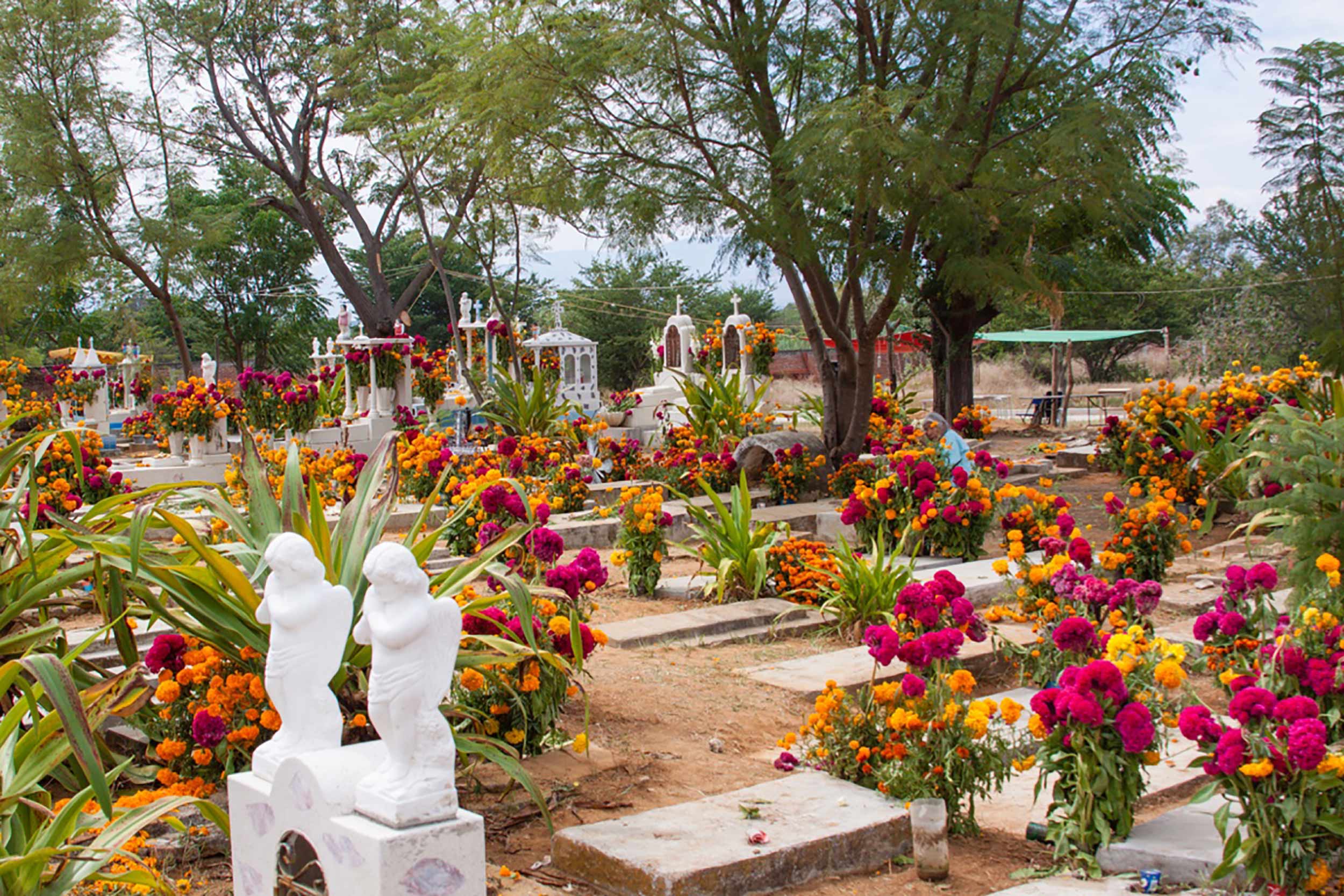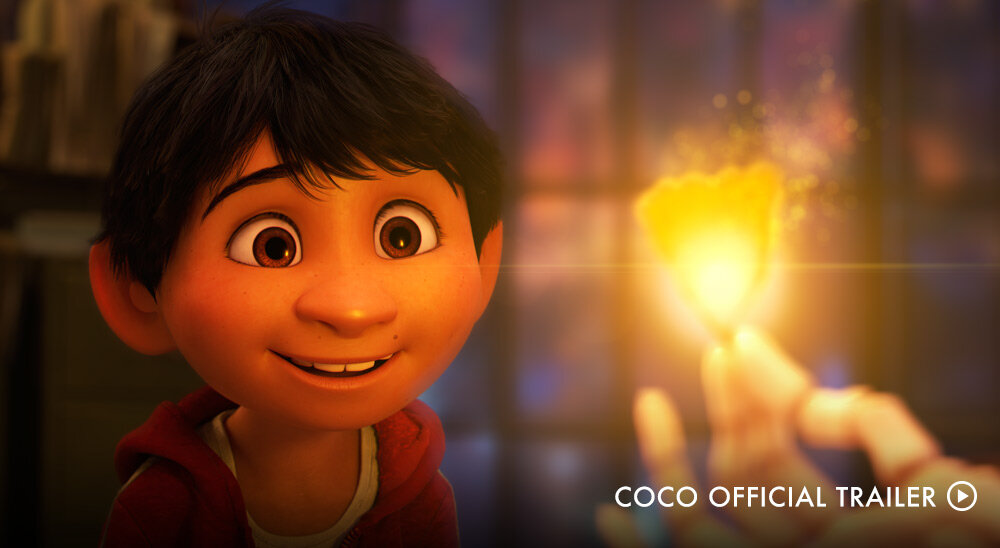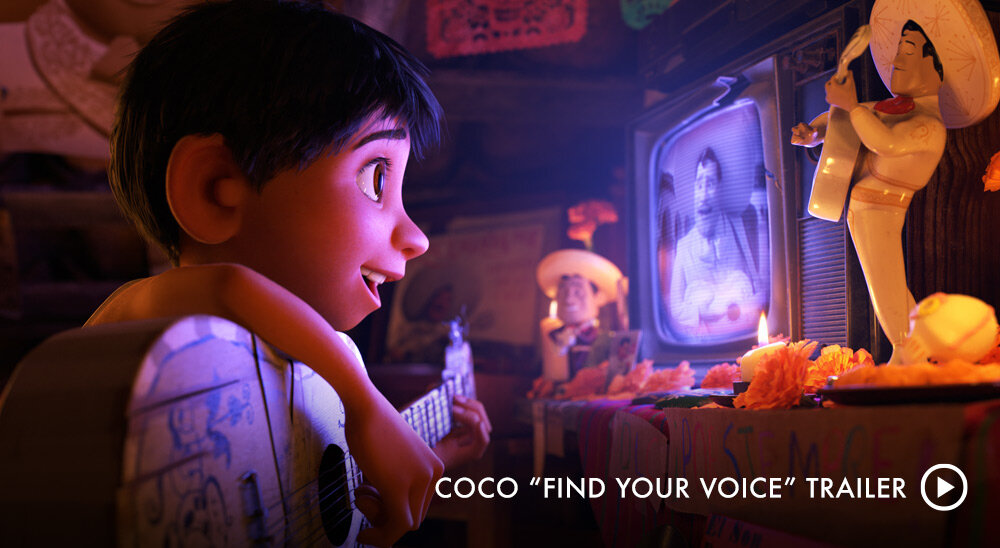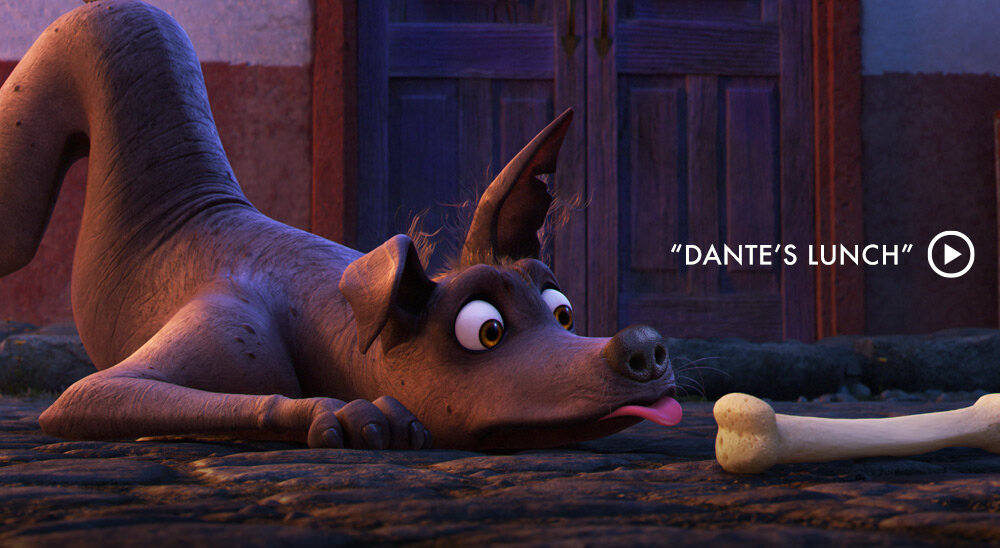
Inhabiting the Land of the Dead is a rich and vibrant community. But these characters had to be built without many of the usual traits because they are all skeletons. “We had to figure out how to give them personality without skin, muscles, noses or even lips,” says character art director Daniel Arriaga. “We played with shapes and did a lot of paintings. We sculpted and studied skulls from every angle to figure out where we could add appeal and charm.”
Miguel
Miguel is a 12-year-old who struggles against his family’s generations-old ban on music. “Miguel secretly nurtures this love of music,” says director Lee Unkrich. “He’s constructed a guitar and designed it to mimic Ernesto’s iconic skull guitar. And he’s taught himself to play.”
Héctor
Héctor, a charming trickster in the Land of the Dead, enlists Miguel’s help to visit the Land of the Living. “He desperately wants to cross the marigold bridge on Día de los Muertos,” says co-director Adrian Molina. “But there's a rule that if no one in the Land of the Living is actively remembering you—if no one has put your photo up on an Ofrenda—then there's no one in the Land of the Living to receive you and you cannot cross over.”
Dante
Dante is a Xolo dog—short for Xoloitzcuintli—the national dog of Mexico. Nearly hairless, Dante has trouble keeping his tongue in his mouth due to his missing teeth—but he’s a loyal companion to Miguel. “Dante is Miguel’s confidant, the only character he shares his music with,” says screenwriter Matthew Aldrich.
Ernesto de la Cruz
Miguel’s idol Ernesto de la Cruz, is the most famous musician in the history of Mexico. Revered by fans worldwide until his untimely death, the charming and charismatic musician is even more beloved in the Land of the Dead. “Ernesto de la Cruz’s catchphrase was ‘Seize your moment,’” says director Lee Unkrich. “And Miguel takes that to heart.”
To support Miguel’s adoration of Ernesto, filmmakers realized they would need to build the career of the fictional performer. Co-director Adrian Molina teamed up with songwriter/composer Germaine Franco to write some of the songs in Ernesto’s repertoire. “Music is important to Miguel and it anchors Ernesto’s character,” says Molina. “So we wanted to write a few songs that would demonstrate the kind of performer that Ernesto was and maybe show what makes him so popular.”
Abuelita
Abuelita is Miguel’s grandmother and the ultimate enforcer of the Rivera family rules. She loves her family very much and will do anything to protect them. But when she gets angry, she wields a mean shoe. “Abuelita is the torchbearer when it comes to the family’s rule where music is concerned,” says director Lee Unkrich. “She can be warm and loving one moment and sharp-tongued and strict the next. That’s what’s so entertaining about her—you never know what you’re going to get.”
Pepita
Pepita is an alebrije who fills the role of Mamá Imelda’s spirit guide. Brightly colored and fiercely loyal, Pepita is a formidable presence in the Land of the Dead. An imposing wildcat with eagle talons and impressive wings, Pepita is an alebrije brought-to-life. “Alebrijes are traditional brightly colored and handcrafted Mexican folk art,” says story supervisor Jason Katz. “They’re dreamlike animals—lizards with rabbit ears, elephants with butterfly wings—beautifully rendered with striking colors, and we knew from the moment we saw them that they needed to have a place in our story.”
Mamá Imelda
Mamá Imelda, Miguel’s great-great-grandmother, is the matriarch of the Rivera family and the founder of their successful shoemaking business. Miguel meets Mamá Imelda in the Land of the Dead and discovers she really does not share his passion for music. “Imelda is the source of the family’s ban on music,” says director Lee Unkrich. “Long ago, she was married to a musician, but she found that he had very different priorities in life. She wanted to raise a family, but he couldn’t let go of his love of music.”
Frida
Frida, a ground breaking artistic figure in Mexican culture, continues her expressive vision in the Land Of The Dead and is one of Miguel’s first artistic allies, helping him to see that a life of an artist could actually be more than just a dream.
The Music
“Coco” is about family, connecting with loved ones and pursuing your dreams. And according to director Lee Unkrich, it’s all rooted in music. “‘Coco’ has music in its DNA,” says Unkrich. “Music shapes the film. Some characters are musicians, while others want nothing to do with it.”
Co-director Adrian Molina says that the Rivera family’s ban on music did not deter the “Coco” filmmakers. “Our main character, Miguel, is so passionate about music and he is really talented,” says Molina. “So his journey to pursue his dream is naturally filled with music. We have traditional Mexican music, original songs written for the film and a beautiful score by Michael Giacchino.”
According to Unkrich, the filmmakers wanted the film to honor its setting, but with an unexpected quality. “We encouraged the team to be true to traditional Mexican music, but gave them the freedom to embrace new sounds,” he says.
“Our main goal is for the audience to walk away from the film feeling like they visited Santa Cecilia and spent time in the Land of the Dead,” adds Tom MacDougall, executive vice president of music at Disney. “If we can give them an authentic musical experience, it will help them make a lasting connection to the film.”
Fortunately, the Rivera family’s ban on music doesn’t extend to the film itself. “I love the irony,” says producer
Darla K. Anderson. “We have a family with this inexplicable objection to music who live in a country that’s rooted in it. In ‘Coco,’ we pay homage to all different styles of Mexican music.”
Mamá Coco
Miguel’s cherished great-grandmother Mamá Coco is very old and fragile, but that doesn’t stop Miguel from sharing his daily adventures with her. According to Director Lee Unkrich, filmmakers were touched by so many of the Mexican homes they visited in which multiple generations lived under the same roof. “Babies were at home alongside their great-grandmothers,” says Unkrich. “We wanted to embrace that. Even as her own memory is slipping away, Mamá Coco will always be surrounded by people who love her.”
The Rivera Family
Papá, Miguel’s supportive father, hopes that someday Miguel will join him in the family shoemaking business. After all, a Rivera is a shoemaker through and through.
Miguel’s loving Mamá gently encourages her son to embrace their family’s traditions. She and Papá are expecting a new little brother or sister for Miguel.
Miguel’s ancestors also include his late aunt
Tía Rosita, his great-grandfather Papá Julio and his identical twin uncles Tío Oscar and
Tío Felipe.
Chicharrón
Chicharrón is a curmudgeonly friend of Héctor’s who is sadly being forgotten—an unfortunate condition in the Land of the Dead.
Skeletons
Global technology supervisor J.D. Northrup came on board early in the production to address potential issues for “Coco”—and creating skeletons certainly qualified. “The skeletons can detach their bones and do little gags. Even their vertebrae comes apart,” says Northrup. “Each piece had to be independent so the complexity of the rig and the stress that it puts on the pipeline were something like we've never seen before.”
World Design






Research
“As soon as we decided that we wanted to tell a story that takes place in Mexico, we immediately booked our first research trip,” says director Lee Unkrich. “Over the course of three years, we visited museums, markets, plazas, workshops, churches, haciendas and cemeteries throughout Mexico,” says Unkrich. “Families welcomed us into their homes and taught us about the foods they enjoy, the music they listen to, their livelihoods and their traditions. Most importantly, we witnessed the importance they place on family.”
That, according to Unkrich, is what ultimately sparked the story. “We really wanted to explore the family bonds that tie us to the generations that came before us,” he says. “This story is about celebrating our past—even as we look to the future.”
The Land Of The Dead
For the Land of the Living and Santa Cecilia, filmmakers were able to find inspiration in the vibrant towns they visited in Mexico. But when it came time to create the Land of the Dead, the rules were much less defined. “I didn’t want to have just a free-for-all, wacky world,” says director Lee Unkrich. “There needed to be some logic to it. We realized that it would need to be ever-expanding because new residents would arrive regularly, if you think about it. So we asked ourselves, ‘What would a world look like that was being added onto constantly?’”
Filmmakers looked to Mexico City’s ancient history. The city was originally built on the site of the Aztec city of Tenochtitlán, which was surrounded by water. And while that water has mostly disappeared, artists found the idea very compelling—a city literally sprung from the water. “That lent itself to this idea of towers,” says Unkrich. “Almost like coral growing up and out representing layers of history.”
Santa Cecilia
“Santa Cecilia is inspired by real villages in Mexico,” says production designer
Harley Jessup. “We stayed grounded in reality in the Land of the Living. It’s sun-bleached and dusty, but the color palette is accented by the brightly colored decorations for Día de Muertos. There’s a town square where people gather, the Rivera compound where Miguel’s great-great-grandmother built the family’s shoe business, and the local cemetery is prominently featured.”
Cemetery
As the locals prepare for Día de Muertos, the Santa Cecilia cemetery is filled with brilliantly colored marigolds and celosia blossoms, as well as handmade decorations and hundreds of candles. “What we saw in Mexico for the holiday really redefines the idea of a cemetery,” says Danielle Feinberg, director of photography - lighting. “It’s not dark and sad; it’s festive. Thousands of candles put off this beautiful orange glow, which creates a wonderful mood—romantic, warm, and interesting. I’ve never seen anything like it.”
The Marigold Bridge
As filmmakers created the two worlds of “Coco,” they knew they’d need to connect the worlds in a very magical way. Their research trips sparked something spectacular. “When we were invited to take part in Día de Muertos in Mexico,” says director Lee Unkrich, “we saw paths made of marigold petals that started out in the streets and ended at ofrendas—altars with family pictures, favorite foods and special objects. We learned that it was all done to help guide the spirit of a family’s loved one home.”
Las Ofrendas
During the Día de los Muertos celebration families create ofrendas (altars) which honor the spirits of loved ones who have passed.
The Department of Family Reunions
Located within Marigold Grand Central Station is the Department of Family Reunions, where all of the family records are kept. According to Production Designer Harley Jessup, the space is designed in the spirit of a “Victorian DMV,” with skull and skeleton motifs incorporated into the architecture.
Families come to the Department of Family Reunions if they’re having problems with crossing over to the Land of the Living. Employed here is a clerk, who assists Miguel and his family in his cluttered, yet cozy office
Credits







































































































































































